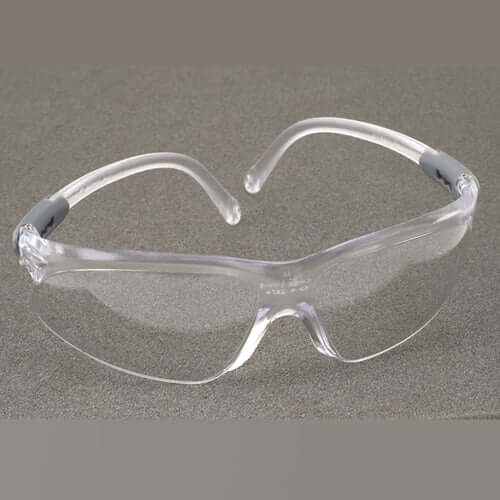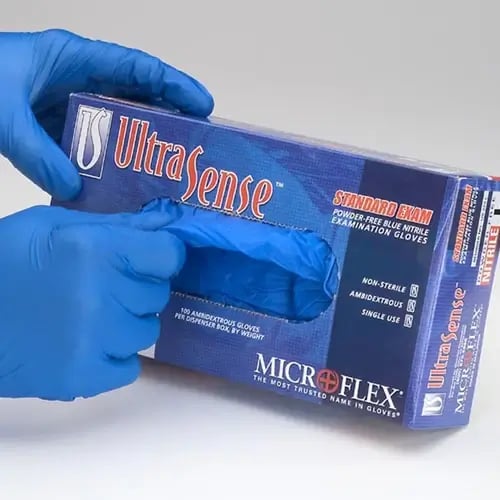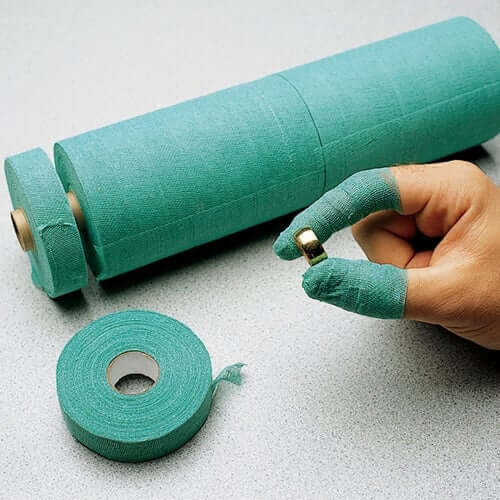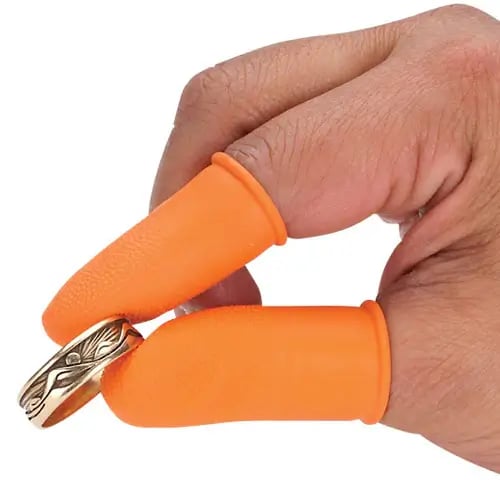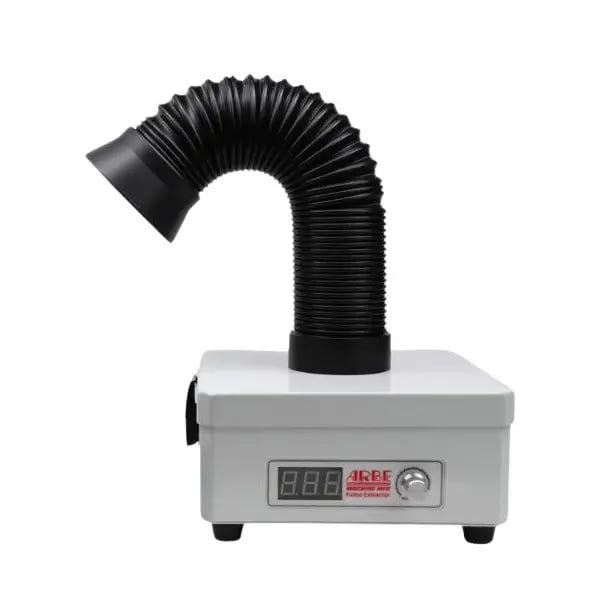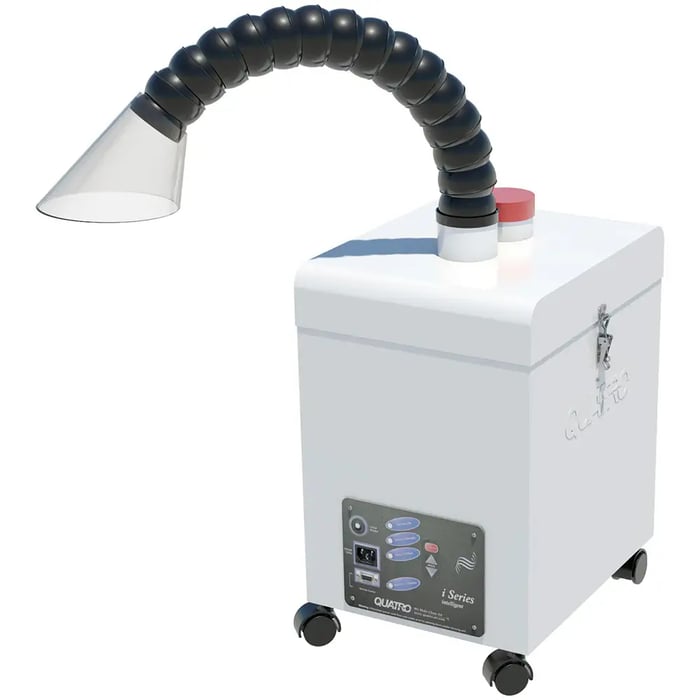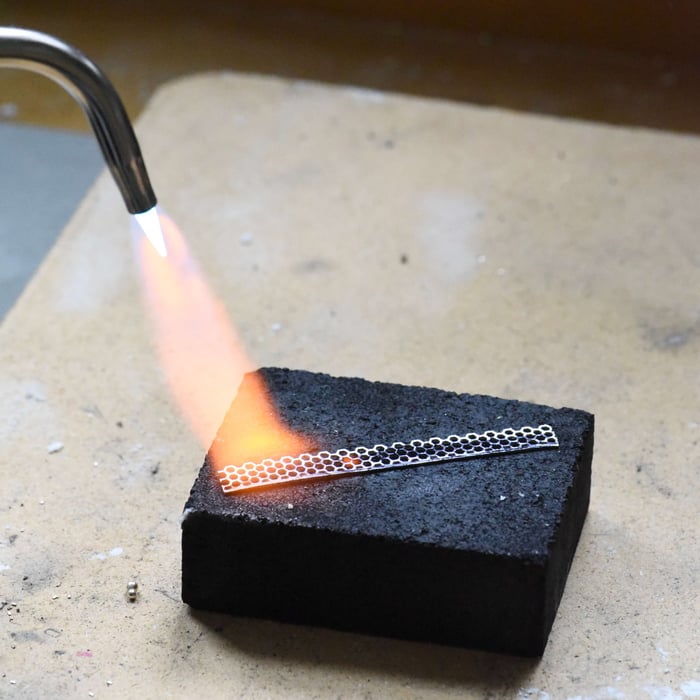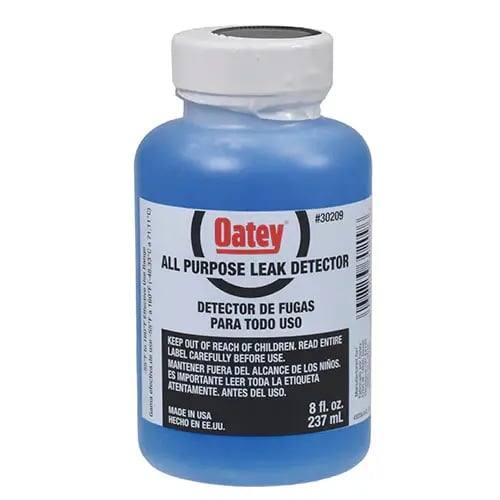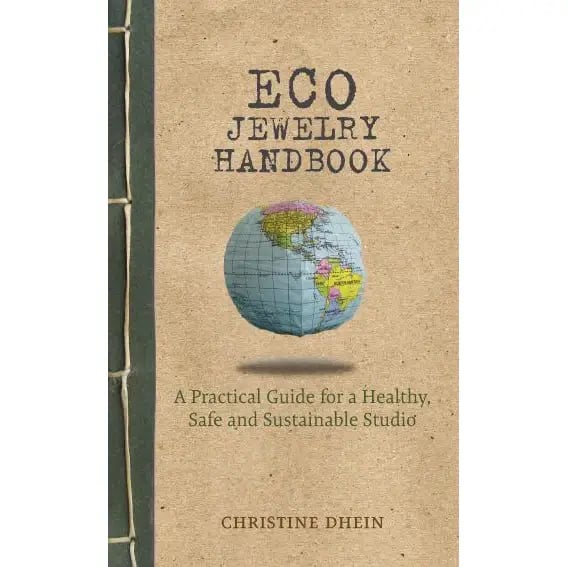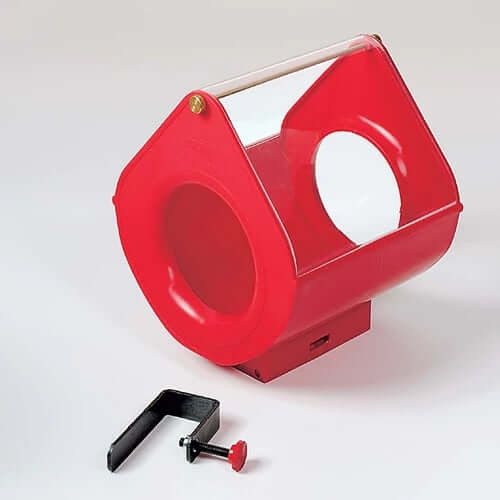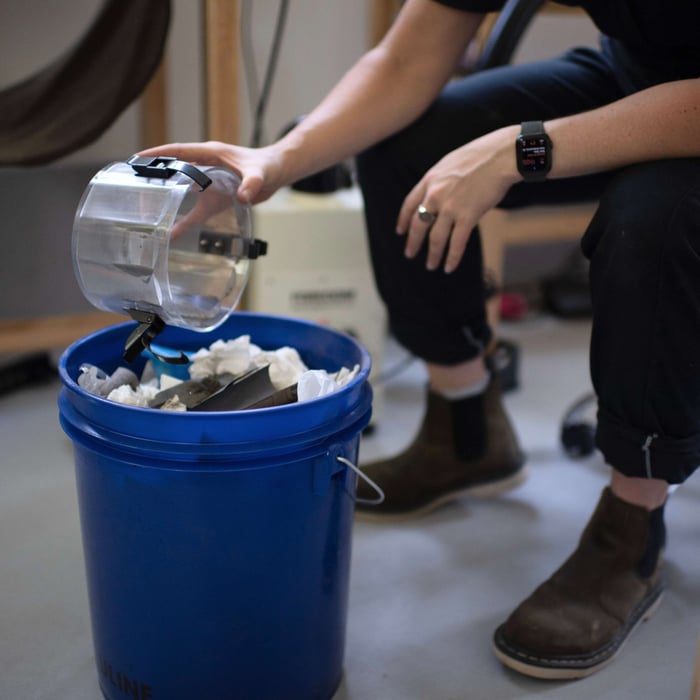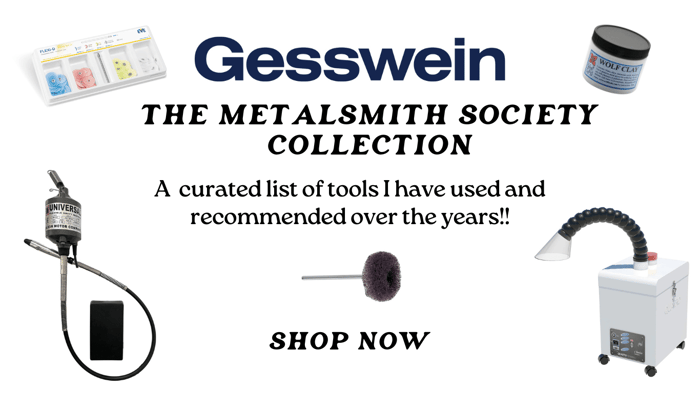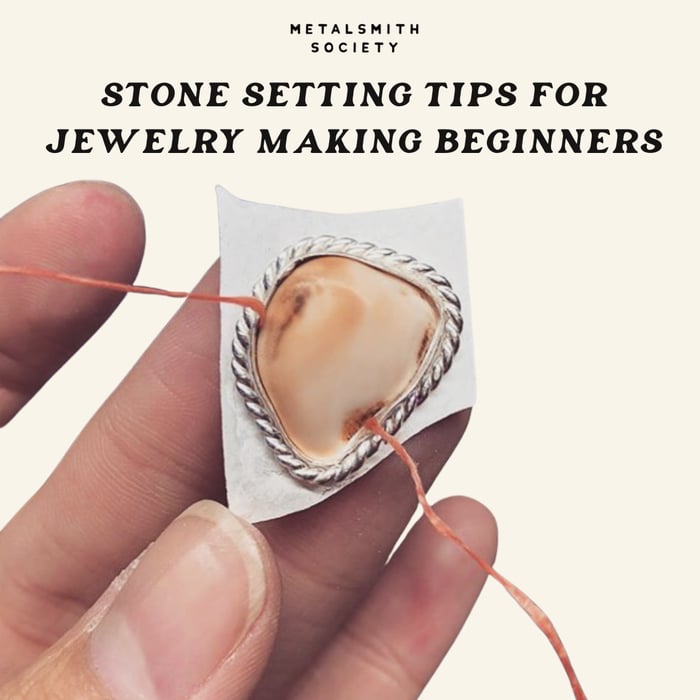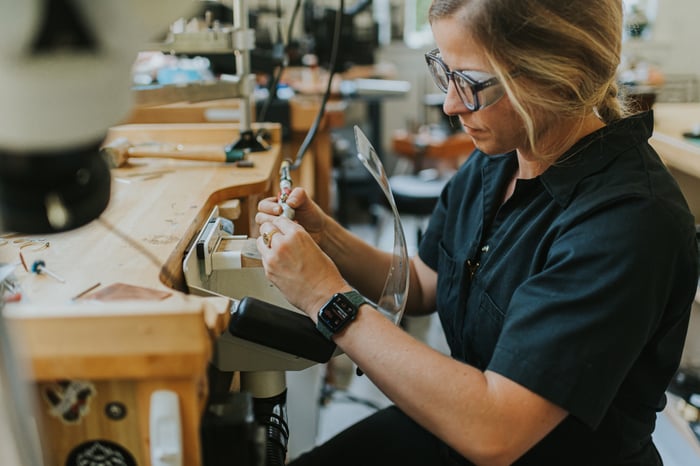 I'm going to start this article with an important disclaimer: when it comes to your safety in the jewelry studio, especially regarding chemicals and materials, educating yourself is essential! I am not providing health or medical advice. I am sharing essential safety tools + tips to help you create a healthier studio environment, whether you're a student, hobbyist, or professional!
I'm going to start this article with an important disclaimer: when it comes to your safety in the jewelry studio, especially regarding chemicals and materials, educating yourself is essential! I am not providing health or medical advice. I am sharing essential safety tools + tips to help you create a healthier studio environment, whether you're a student, hobbyist, or professional!
This post contains affiliate links, which means I may earn a small commission at no extra cost to you if you make a purchase through these links. Your support helps me continue to create free educational resources like this blog—thank you! 😊
Every studio needs these items:
Before diving into specific safety tips, here are a few must-have items that every jewelry studio should be equipped with:
- Fire Extinguisher – Keep one within easy reach, especially near your soldering station. Make sure it’s rated for electrical and chemical fires.
- First Aid Kit – Accidents happen! A well-stocked kit with bandages, burn cream, and antiseptic wipes is essential.
- Eye Wash Station or Saline Solution – If chemicals or debris get in your eyes, you need immediate relief.
- Emergency Contact Information & MSDS Sheets – Have a printed emergency contact list and Material Safety Data Sheets (MSDS) for any hazardous chemicals in your studio.
Essential Contacts for a Jewelry Studio Emergency List
Local Emergency Services – 911 (or your country’s emergency number)
- Fire, medical, and police response.
Poison Control Center – 1-800-222-1222 (U.S.)
- In case of accidental chemical exposure, inhalation, or ingestion.
Nearest Hospital or Urgent Care
- Write down the name, address, and phone number of the closest medical facility.
Local Fire Department (Non-Emergency Line)
- For reporting fire hazards or requesting guidance on fire safety in your studio.
Local Police Department (Non-Emergency Line)
- In case of theft, break-ins, or security concerns.
Gas and Electric Company Emergency Line
- To report gas leaks, power outages, or electrical hazards.
Personal Emergency Contact
- A family member, friend, or partner who should be notified in case of an accident.
MSDS (Material Safety Data Sheets) Reference
- Keep a printed copy of MSDS sheets for chemicals in your studio. If an exposure happens, you’ll have quick access to safety procedures.
Insurance Provider
- If you have business insurance or a jewelry-specific policy, keep your agent’s contact info handy.
Jewelry Studio Landlord or Building Maintenance (If Applicable)
- If you rent your space, have your landlord’s or building maintenance number available for facility issues.
General Safety Gear
Before you start working at the bench, make sure you’re properly geared up! Jewelry making involves heat, chemicals, sharp tools, and airborne particles, so wearing appropriate clothing and safety equipment is just as important as your creative skills. Wearing protective gear not only keeps you safe but also allows you to work more confidently and comfortably. Below are the must-have safety items every jeweler should have in their studio.

Safety Goggles - Always wear safety glasses or goggles to protect your eyes from flying debris. Keep your safety goggles on at all times! I recommend a lightweight pair like these from Gesswein because they offer great protection and are comfortable to wear all day.
Masks + Respirators - Use a dust mask or respirator when working with materials that produce fine particles or fumes, such as polishing compounds or chemicals. An N95 mask filters over 90% of airborne particles, fumes, and chemical odors, You can alternately get 3M™ Half-Facepiece Respirator with vapor cartridges. I can speak from personal experience that the respirator can be challenging to wear for hours but it does provide more protection than the mask. Dust and fume collection systems are superior and I will cover that as well, but masks and a respirator should still be on hand for times you need to move freely around your studio and protect yourself. You can also double down and use the machines while wearing the mask!
Rubber Gloves - Wear gloves when handling chemicals like flux and patina to avoid direct contact. I love that the brand below comes in size small and medium! In addition to gloves, consider using safer options for patina, fluxes, and other common chemicals. This is outlined in Christine Dhein’s book which I will also cover in this article. Beware: never wear gloves while operating a polishing machine, as they can get caught and cause serious injury.
Finger Tape - This tape wraps tightly around your fingers and offers ideal protection during buffing and grinding, benchwork and other jobs for which gloves are too awkward or dangerous. Protects fingers, hands and wrists from the common hazards of sharp edges, hot surfaces and abrasive materials. I like this tape because it's width is perfect for finger wrapping! Also helpful if you have a cut you need to keep clean and protected! Place in the refining bucket when spent!
Finger Guards - I am a huge fan of finger guards that can be used while sanding, polishing, grinding, or even if you have a cut you need to cover and keep clean! You need to purchase two sizes, one for your pointer finger and one for your thumb! Same deal if they get worn out and potentially have metal imbedded in them be sure to place in your refining bucket!
Earmuffs - Protect your hearing! I love my 3M earmuffs when hammering or using noisy tools. These are easy to keep on hand and make a huge difference in reducing long-term hearing damage. Check your local hardware store and support a small business.
Apron or Coverall – Jewelry work gets messy! A flame-resistant apron or coverall protects your clothing from chemicals, metal shavings, and hot items. If you’re working with heat, avoid synthetic fabrics—they can melt onto your skin. A heavy-duty cotton or leather apron is a great investment. I also love the work pants and overalls from Dovetail Workwear.
Closed-Toe Shoes – Protect your feet from falling tools, hot metal, or spilled chemicals. Avoid sandals or open-toe shoes in the studio. If you do a lot of soldering, leather boots offer extra protection in case of dropped molten metal (yep, it happens!).
Soldering Safety: Protect Yourself & Your Studio
Before you even fire up your torch, make sure you’re set up for safety! Tie back your hair (seriously, no one wants a flaming ponytail), wear protective clothing and closed-toe shoes, and put on your safety glasses. Your workspace should be clear of flammable materials—no loose papers, curtains, or anything else that could catch fire. A well-organized and fire-safe setup is just as important as your technique. Now, let’s talk about tools to keep you safe while soldering!
Why You Need Fume Extraction At Your Soldering Bench
Fume extraction isn’t just a nice-to-have—it’s essential for protecting your health and creating a safer workspace. Here’s why every jeweler should invest in a fume extractor or ensure proper ventilation in their studio:
1. Protect Your Lungs from Toxic Fumes
- Soldering produces harmful fumes, especially when using fluxes that contain chemicals like fluoride, which can irritate your lungs.
- Pickle solutions (like sodium bisulfate) release vapors that can cause respiratory issues with prolonged exposure.
- Adhesives and patinas often contain volatile organic compounds (VOCs), which can lead to dizziness, headaches, or long-term health problems if inhaled regularly.
- Wax work for lost wax casting also creates fumes which can be harmful.
2. Reduce Exposure to Heavy Metals
- When heating metals like silver, gold, brass, and copper during jewelry making, small metal particles can become airborne, posing health risks if inhaled.
- Certain metals, like nickel or cadmium (found in some solders), are toxic and should never be inhaled.
3. Improve Air Quality and Comfort
- Working in a poorly ventilated space can lead to eye irritation, throat discomfort, and fatigue.
- Fume extraction keeps your studio air fresh and breathable, making long bench sessions more comfortable.
4. Minimize Fire Hazards
- Proper ventilation helps prevent the buildup of flammable vapors from certain chemicals.
- An extractor keeps fumes from lingering, reducing the risk of accidental ignition near an open flame.
5. Keep Your Workspace Cleaner
- Without ventilation, soot, metal dust, and flux residue can settle on surfaces, making your bench area harder to clean.
- A good fume extractor captures particles before they spread throughout your studio.
6. Long-Term Health Protection
- Chronic exposure to soldering fumes and chemical vapors can lead to serious health issues, including respiratory diseases and skin sensitivities.
- Investing in proper fume extraction is a preventative measure that ensures you can continue making jewelry safely for years to come.
I don't mention all of this to make anyone scared I just want you to be informed! Fume extraction isn’t just a nice-to-have—it’s essential for protecting your health and creating a safer workspace.
Affordable Fume Extractor: You can get a compact and affordable unit with a HEPA filter, like the ARBE Tabletop Extractor from Gesswein. helps remove harmful fumes.
Professional Fume Extractor - If you're serious about air quality in your jewelry studio, the Quatro SolderPure Solder / Wax Smoke and Fume Extractor is a top-tier professional option that outperforms smaller tabletop units. While a compact tabletop extractor like the Arbe Tabletop Soldering Fume Extractor is great for small-scale or hobbyist use, the SolderPure system is built for heavy-duty professional work—especially if you solder frequently or work in a shared studio space. I own this one and I love it!
Installing a Fume Extraction System That Vents Outdoors - Setting up a fume extraction system that vents to the outside is an effective way to ensure a safe working environment. A basic setup involves using an inline duct fan connected to flexible aluminum ducting, which directs fumes from your workspace to the exterior of your building. The ducting can be routed through a wall, ceiling, or window, depending on your studio's layout. For window installations, a removable panel made from materials like foam core board can be used to hold a dryer vent, allowing the ducting to pass through while maintaining a seal against the elements. It's important to position the intake of the ducting close to the source of fumes—ideally within 6 to 8 inches—to maximize efficiency. Additionally, ensure that the exhaust outlet is placed away from any air intakes to prevent re-circulation of fumes. Regular maintenance, such as checking for obstructions and cleaning the ducting, will keep the system functioning effectively. Implementing such a system not only enhances safety but also contributes to a more comfortable and professional studio environment. While I don't have instructions on building this system I did find a great tutorial on Nancy L T Hamilton's Blog.
What to Do If You Can’t Afford a Fume Extractor
If a fume extractor isn’t in your budget right now, don’t worry—there are still ways to improve air quality and protect yourself while soldering.
- First, set up your soldering bench near an open window with a strong fan positioned to push fumes away from your breathing space. While this isn’t as effective as a fume extractor, it helps reduce exposure. Open a few windows to help bring in fresh air as well!
- If possible, work in a larger, open space rather than a small, enclosed room where fumes can accumulate.
- Wear a high-quality respirator with an organic vapor filter, like a 3M Half Facepiece Respirator, to reduce inhalation of harmful chemicals. These solutions may not be perfect, but they’re better than nothing—and you can always plan to invest in a fume extractor when your budget allows!
Other Soldering Tools
- Work on a fire-resistant soldering board under your work area to protect your bench. I have always had a Ceramic Soldering Board on top of my bench and then I place my charcoal, Solderite and honeycomb blocks on top of that. It is also the surface I tend to place my solder on.
Additional Soldering Safety Tips + Considerations
Position Your Fume Extractor Properly
- Place your fume extractor as close as possible to your soldering area for maximum efficiency. The flexible hose should be positioned over your work but not so close it will melt (as me how I know!)
Regular Maintenance for Your Fume Extractor
- Clean or replace filters as recommended by the manufacturer to maintain proper airflow and filtration. HEPA and carbon filters lose effectiveness over time.
- If you use a tabletop extractor, check the pre-filter often—it can clog up with dust and soldering residues.
Torch Safety
- Always check for gas leaks before using a torch. I highly recommend using Leak Detector Fluid, do not use standard soap solutions to test for leaks; these solutions may contain combustible ingredients. This fluid will help detect leaks in hoses, connections, and valves. I go more in depth on my blog article on torch safety bookmark that to read as well!
Turn off tanks when not in use – Always shut off the gas at the tank when you’re finished working. To bleed the lines, turn off the gas at the tank and than open the gas control knob to allow all pressure to escape from the hose and regulator. Once the pressure is fully released, close the gas control knob completely.
- Store acetylene, propane, and oxygen tanks upright to prevent leaks and ensure correct gas flow. Use chains or straps to secure tanks, preventing them from tipping over.
- Keep your fire extinguisher nearby!
Safe Disposal of Soldering Waste
- Flux residue, pickle sludge, and used filters should be disposed of properly—don’t wash them down the drain! You should have a hazardous waste bucket for collecting pickle sludge, used flux, and any materials contaminated with metal particles. You can allow this liquid waste to evaporate, outside by placing the bucket outside. The liquid will evaporate leaving behind the solid residue.
- Once your bucket is full, check local hazardous waste disposal regulations to safely dispose of your waste.
There is also the topic of handling soldering chemicals safely which I will cover along with all other chemicals, below.
Safe Handling of Chemicals
- Store chemicals like flux, adhesives, and pickle in clearly labeled, sealed containers. If you have pets or small humans it is critical to place these items out of reach and locked up!
- Follow manufacturer instructions and wear gloves when handling hazardous substances. Regardless of gloves wash your hands thoroughly after using chemicals, I also clean and wipe down surfaces where chemicals may have touched.
- Use chemicals under ventilation, for example I will patina my jewelry on a clean dedicated surface underneath my fume extractor.
- As previously mentioned proper disposal is very important for your health and our environment.
Make Healthier Choices
You absolutely need to purchase a copy of Christine Dhein’s Eco Jewelry Handbook! It is filled with suggestions for non-toxic alternatives for fluxes, patinas and more. It also has important information on all the traditional stuff, stay informed :)
Citric Acid Pickle is a great alternative to Sparex, it is a naturally occurring acid found in citrus fruits and many other foods, that is colorless and odorless. It's gentle on skin and fabrics but tough on firescale and flux residue.
You can also try using household vinegar! Use this simple recipe from @emilieshapirojewelry:
1 cup distilled vinegar
1 tablespoon table salt
While vinegar is natural, once used as pickle, it contains metal particles and should not be poured down the drain. Collect it in a bucket, let it evaporate, and take the remaining sludge to your local hazardous waste drop-off.
Flex Shaft & Polishing Machine Safety: Protecting Your Hands, Eyes, and Lungs
 Here I am working with my Foredom Dust Collector, wearing safety glasses, hair tied back, no loose clothing and closed toe shoes.
Here I am working with my Foredom Dust Collector, wearing safety glasses, hair tied back, no loose clothing and closed toe shoes.Flex shafts and polishing machines are essential tools for jewelers, but they come with safety risks that need to be addressed. These tools rotate at high speeds, generating metal dust, polishing compound debris, and the potential for serious injury if not used correctly. Here’s how to stay safe while using them:
Eye Protection is a Must
- Always wear safety glasses to protect against flying debris, metal dust, and loose polishing compounds.
- If you work with high-speed rotary tools, consider wraparound goggles or a face shield for extra protection.
Protect Your Hands—No Gloves!
- Never wear gloves when using a flex shaft or polishing machine—they can get caught in the rotating tool and pull your hand in, leading to serious injury. Instead, use finger guards or tape for protection from abrasions and heat buildup.
- Never, ever wrap your work around your fingers when polishing. Especially with a polishing machine. If a chain gets pulled in and you've wrapped it your hand is going with it!
Important Rule: Never Polish Chain with a Rotary Tool!
Polishing chain with a rotary tool—whether it’s a flex shaft, polishing motor, or buffing wheel—is extremely dangerous. The high-speed rotation can catch the chain, wrapping it around the tool or pulling it out of your hands in an instant OR pulling your hand in! This can result in serious injury, damage to the chain and damage to your tool. Instead you can use a tumbler, hand polish with a cloth or use a soft brush and polishing compound.
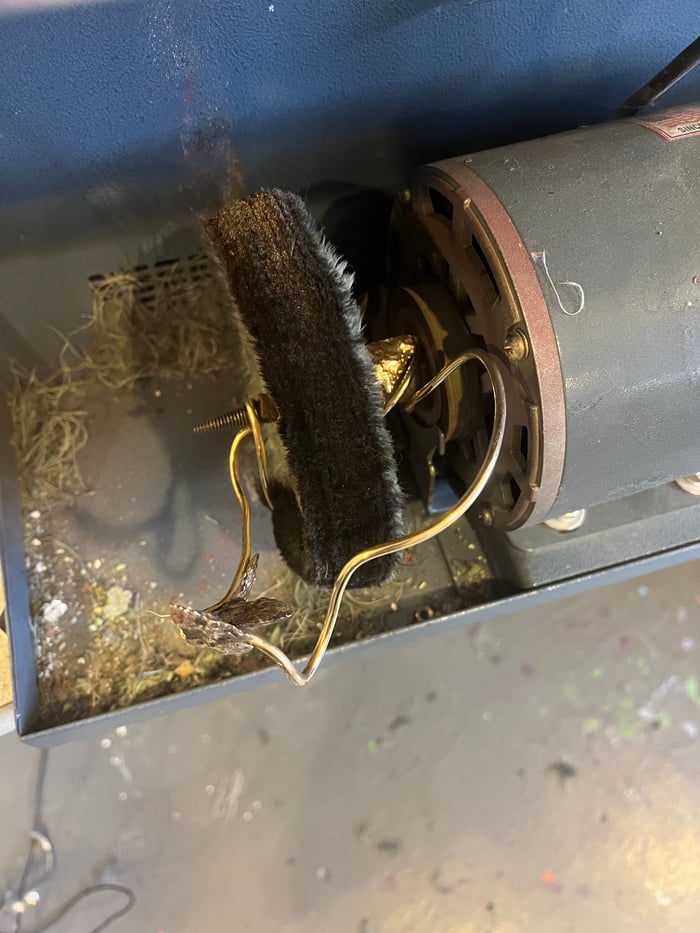 Even experienced jewelers can have an accident! @theresaapplegatejewelry shared an accident where a large necklace got pulled into her polishing machine. Thankfully she was not hurt, if her hand had been wrapped around the piece she would have! I appreciate her honesty in sharing this so others can learn from it!!
Even experienced jewelers can have an accident! @theresaapplegatejewelry shared an accident where a large necklace got pulled into her polishing machine. Thankfully she was not hurt, if her hand had been wrapped around the piece she would have! I appreciate her honesty in sharing this so others can learn from it!!When you're using a polishing machine, steer clear of polishing big, bulky items that could get snagged or caught. Trust me, it’s not worth the risk of having something whip out of your hands or worse, cause an injury. If you’re feeling unsure about a piece, go the safer route and hand polish it instead. It might take a little longer, but your fingers (and nerves) will thank you!
Tie Back Hair & Avoid Loose Clothing
- Loose hair, clothing, or jewelry can get tangled in a spinning rotary tool. Tie back your hair, roll up loose sleeves, and remove dangling jewelry before working. I have seen pictures and videos of jewelers loosing a chunk of hair. It could be as simple as your flex shaft is hanging down, you are looking for a stone and you accidentally press the foot pedal.
Keep a Firm Grip & Use the Right Speed
- Always hold your work securely!
- Use the appropriate speed setting for your task. Running a tool at full speed unnecessarily increases the risk of accidents.
Dust Collection
- Polishing compounds, metal dust, and abrasives can create fine airborne particles that are hazardous to your lungs.
- Use a dust collector or wear a respirator (N95 or higher) if working in an area without proper ventilation.
- Use a Matt™ Gold Collector Box to Minimize Dust Exposure
When grinding, sanding, or polishing jewelry, fine metal dust can become airborne and pose a risk to your health over time. A tool like the Matt™ Gold Collector Box helps trap those precious particles right at your bench. Not only does it make it easier to collect gold and silver dust for refining, but it also reduces what you’re breathing in. It’s a win-win for your lungs and your scrap jar! It is a cost effective choice, but there are limitations to working inside of it.
Invest in a Dust Collector: Why It’s Essential
A dust collector is one of the best investments you can make for both health and efficiency in your jewelry studio.As mentioned when sanding, polishing, or grinding, tiny particles of metal and polishing compound are released into the air asmentioned a dust collector creates a safer work environment but it also capture valuable metal that can be reclaimed!
Recommended Dust Collection Systems:
- Foredom Dust Collector – A compact, high-efficiency option that captures dust at the source. This one I personally have, I love the clear canister that makes it easy to place all your gold and silver dust into a refining bucket! For this one I attach it to my bench using the Foredom Fishmouth with Shield.
- Quatro Basic Dust Collector – This one has a small footprint and you purchase a separate attachment for the hose to capture the dust!
Send Your Collected Dust to a Refiner
I know, I have been talking about it throughout this article!! Did you know that the metal dust collected in your polishing machine, dust collector, or even workbench tray can be refined for credit or cash? Over time, these particles add up to real value!
- Use a refining service to process your dust, used buffing wheels, and even old emery paper.
- If you’re using a dust collector, regularly empty the collected dust into a container and store it for refining.
- For step-by-step instructions on how to prepare and send dust for refining, check out my refining blog post for all the details.
Use Tools and Machinery Correctly
Keep fingers and loose clothing away from rotating tools like drills or polishers.
Regularly inspect and maintain your tools to ensure they are in good working condition.
Use clamps or holders to secure workpieces instead of holding them by hand.
Prevent Bruises + Tripping
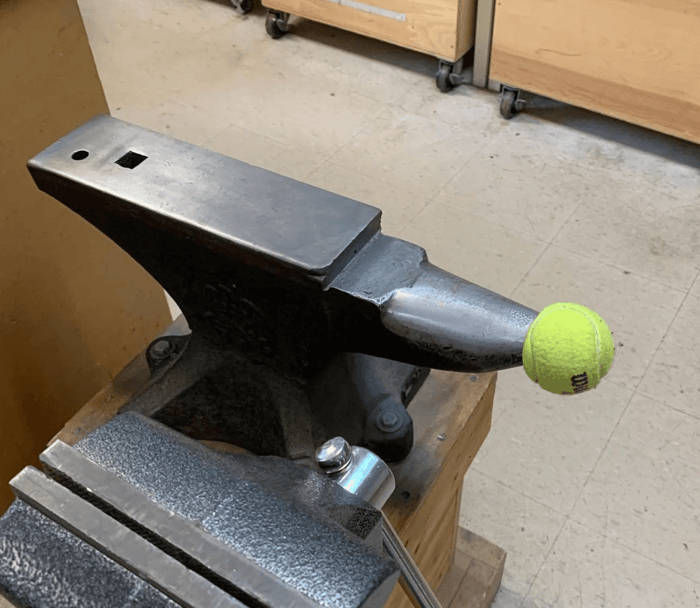 I took this picture while taking a class at Metalwerx in MA. Thought it was a genius solution!
I took this picture while taking a class at Metalwerx in MA. Thought it was a genius solution!Get creative where you need to but avoid sharp tools sticking out where you may bump them.
Avoid anything in walkways that could cause a trip!
Prevent Fire Hazards
Always have a fire extinguisher in your studio, ideally rated for chemical and electrical fires.
Keep flammable materials like alcohol and paper towels away from your torch area.
Never leave your torch unattended when it’s on.
Practice Electrical Safety
Avoid using damaged or frayed cords, and keep electrical outlets free of overload.
Use surge protectors for your equipment.
Unplug tools when not in use to reduce the risk of electrical accidents.
Stay Focused
Don’t zone out while using sharp tools or heavy machinery. Stay focused, and if you’re tired, call it a day. Jewelry-making can wait—your safety can’t.
Never work when tired or under the influence of substances that could impair your judgment.
Ergonomic Workspace
Set up an ergonomic workspace. Use an adjustable jeweler’s bench and chair to reduce strain on your back and shoulders.
Take breaks to stretch and prevent repetitive strain injuries, especially in your hands and wrists.
Consider eye strain. Use magnification when needed to avoid straining your eyes and neck. I love my CraftOptics!
These are great safety tips for all jewelers, whether you’re just starting out or have years of experience. If you have other suggestions, please share them with our community by emailing me at corkie@metalsmithsociety.com.
If you’d like to support Metalsmith Society, you can shop my affiliate links at Gesswein, I have partnered with them to create a page that has the tools featured in this blog and other tools I recommend for your shopping convenience! They have also provided us with a code to save 5% every time you shop using code MSS5.
Other ways to support Metalsmith Society are by becoming a Patreon or making a purchase from the Society Shop. Thank you for reading, and I hope you found this helpful!
Metalsmith Society Crossbody Bag
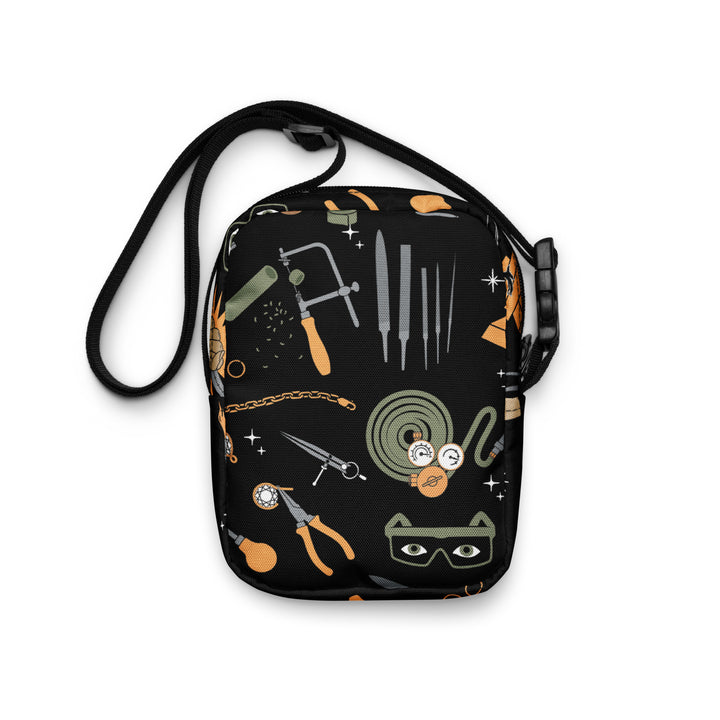
$38.00
This crossbody bag features artwork from one of my all-time favorite Metalsmith Society collaborations, created by artist Anja Slibar. The print highlights jewelry-making tools and metalsmith essentials — a wearable (and usable) nod to the tools of our trade and… read more



